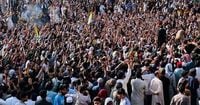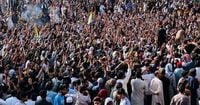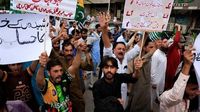Days of turmoil in Pakistan-administered Kashmir have drawn to an uneasy close, as authorities and protest leaders reached a sweeping agreement on October 4, 2025, after violent demonstrations left at least 10—and possibly as many as 12—dead and hundreds more injured. The region, often referred to as Pakistan Occupied Kashmir (POK), was brought to a standstill by the unrest, which saw widespread shutdowns, paralyzed public transport, and a communications blackout that began on September 26.
According to the Associated Press, the breakthrough followed two intense days of negotiations in Muzaffarabad, the capital of Pakistan-administered Kashmir, between government representatives and the Awami Action Committee, a civil rights alliance at the forefront of the protests. Prime Minister Shehbaz Sharif had dispatched a high-level delegation to the region, signaling the gravity of the crisis and the government’s mounting pressure to find a resolution.
The final deal, as reported by India Today, represents a significant climbdown by the Sharif-led coalition government, which agreed to 25 out of the 38 demands put forth by the demonstrators. The protesters, represented by the Jammu Kashmir Joint Awami Action Committee (JKJAAC), had issued their charter in late September, warning that failure to address their grievances would lead to mass action—a promise they swiftly fulfilled when talks initially collapsed.
Among the most pressing issues for the demonstrators were the costs of wheat and electricity, both of which the government agreed to continue subsidizing. But the agreement goes much further. It promises compensation for those killed in the violence, reforms to public health and education, and substantial infrastructure commitments. Federal Minister Tariq Fazal Chaudhry, announcing the agreement on X (formerly Twitter), called it "a victory for peace," adding, "Negotiating delegation has signed the final agreement with the Action Committee.... The protesters are returning to their homes. All roads have been reopened. This is a victory for peace."
Protest leaders expressed cautious optimism about the deal’s prospects. Shaukat Nawaz Mir, who leads the alliance, told reporters, "I am grateful to the Prime Minister Shehbaz Sharif and the whole of Pakistan for understanding our problems and agreeing to resolve them." Mir also confirmed that the protests had ended and that he was "fully satisfied with the outcome of the talks." Still, memories of similar protests in 2024—after which most government promises went unfulfilled—have left many residents wary, even as they hope this time will be different.
The agreement’s details reflect the scale of the unrest and the breadth of local grievances. According to India Today, the government pledged a PKR 10 billion aid package to improve the region’s electricity system and agreed to set up two new educational boards for Muzaffarabad and Poonch divisions. Health care was another sticking point: within 15 days, health cards are to be issued for free treatment, and MRI and CT scan machines will be provided in each district, phased in over time. The deal also calls for feasibility studies on the construction of two tunnels in the Neelum Valley and the development of an international airport at Mirpur—ambitious infrastructure projects aimed at boosting connectivity and economic prospects.
To further address economic concerns, the government agreed to bring property transfer taxes in line with those in Punjab and Khyber Pakhtunkhwa within three months. A monitoring and implementation committee will oversee the progress of these promises, a nod to the protesters’ skepticism after past disappointments.
The unrest, which began on September 29 after talks broke down, quickly escalated into one of the largest protest movements in the region’s recent history. The demonstrations were not just about bread-and-butter issues; they also reflected deep frustration with what many see as the excesses of the military and the perceived failure of the Army-backed Sharif government to deliver on previous commitments. Violent clashes with police resulted in at least 12 deaths—including three police personnel—and hundreds of injuries. During the peak of the protests, Muzaffarabad and other major towns were virtually locked down, with only motorcycles and a handful of private vehicles navigating the deserted streets.
In the aftermath, the government’s response was two-pronged: compensation for the victims and stern legal action for those involved in violence. The agreement stipulates that cases of terrorism will be registered for incidents of vandalism and violence that resulted in deaths. This dual approach was intended to placate public anger while reasserting state authority.
The crisis quickly drew attention from across the border. India, which claims the entire territory of Kashmir, seized the opportunity to criticize Pakistan’s handling of the region and its broader policies. In a statement, the Ministry of External Affairs (MEA) described the unrest as "a natural consequence of Pakistan's oppressive approach and systemic plundering of resources from these territories." MEA spokesperson Randhir Jaiswal called on the international community to hold Pakistan accountable for "horrific human rights violations" in POK and reiterated India’s longstanding position that the territory is under Pakistan’s "forcible" and "illegal occupation."
Pakistan, for its part, has often pointed fingers at India during times of turmoil in Kashmir. Federal minister Ahsan Iqbal, addressing the protesters, warned them not to "light a fire that could benefit our enemy country," a veiled reference to India. This tit-for-tat rhetoric has become almost routine in the geopolitics of Kashmir, a region divided between the two nuclear-armed neighbors since partition and the subject of repeated conflict and diplomatic sparring.
As the dust settles, the people of Pakistan-administered Kashmir are left waiting to see whether the government will deliver on its latest promises. Many in the region remain skeptical, scarred by the memory of last year’s protests and the government’s subsequent inaction. The establishment of a monitoring committee and a clear timeline for reforms are positive steps, but the true test will be in the coming weeks and months, as residents look for tangible improvements in their daily lives.
For now, the streets of Muzaffarabad and other towns are quiet again. But the underlying grievances—over governance, economic hardship, and political autonomy—have not disappeared. Whether this agreement marks a genuine turning point or simply another pause in a long cycle of unrest remains to be seen.






